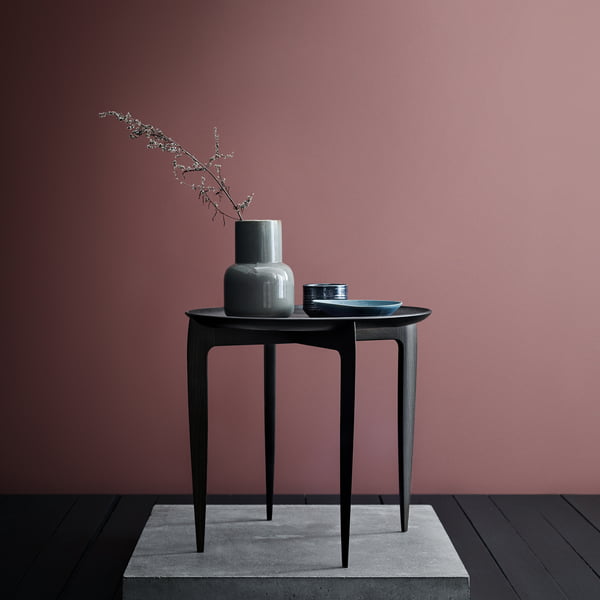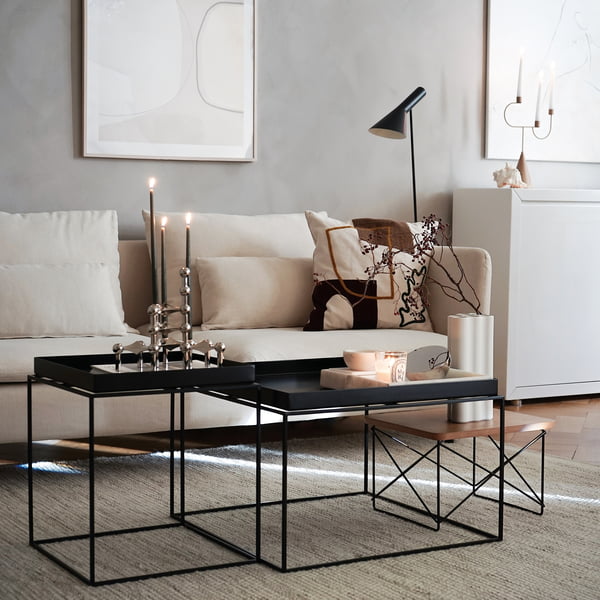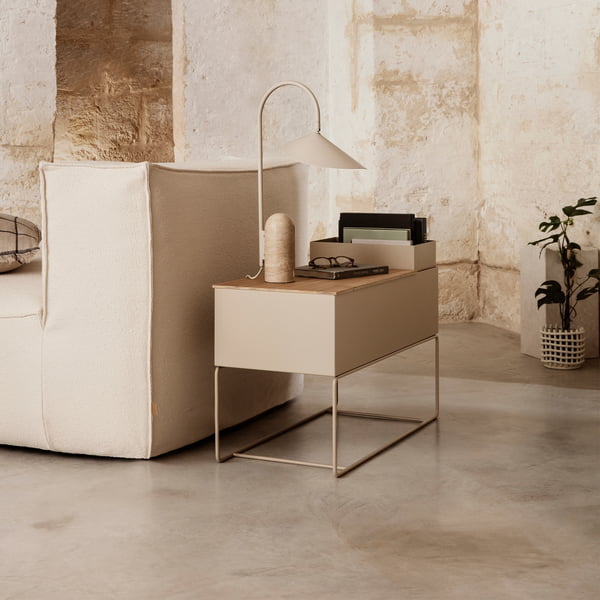Design Side Tables - How to Find the Right Model for Your Home
- Side tables vs. coffee tables
- Round or square?
- Side tables reinterpreted
- Mix & Match of side tables - this is how it works
- Metal, wood or glass - how to choose the right material
- Conclusion
1. Side tables vs. coffee tables - what is the difference
While side tables are characterised by a maximum diameter of 60 cm and can be up to 70 cm high, coffee tables are usually solitary furniture, which are flatter and have a larger diameter.
Whether as a bedside table in the bedroom, as a shelf in the entrance area or anywhere else where you want to store something but do not want to place a heavy piece of furniture, side tables are the right choice. They are handy and allow easy movement and versatile use. Many designer side tables even already have a handle that makes them easier to carry.
That's why you don't have to worry about whether the size is proportional to the size of the sofa and whether there is still enough space before you buy.
 "Side tables at the sofa can be an attractive and practical addition to the coffee table. You can place them directly next to the solitaire furniture or as required, e.g. next to the sofa armrests. Many brands therefore offer coffee tables and side tables in the same design. In this way you create a sense of belonging together in the room, even if they are not directly connected." - Viktoria, furnishing expert
"Side tables at the sofa can be an attractive and practical addition to the coffee table. You can place them directly next to the solitaire furniture or as required, e.g. next to the sofa armrests. Many brands therefore offer coffee tables and side tables in the same design. In this way you create a sense of belonging together in the room, even if they are not directly connected." - Viktoria, furnishing expert
2. Side table for the couch: round or square?
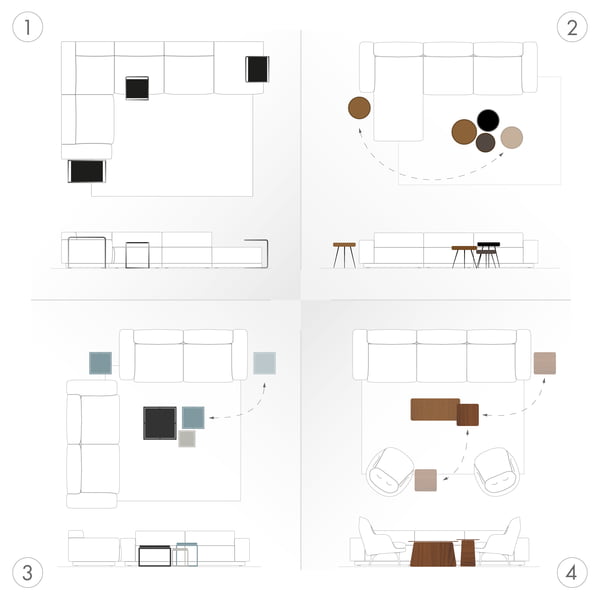
In terms of shape, a C-shaped side table (1), which can be slid over the sofa surface and can even replace armrests, is the right choice for projecting L-shaped sofas and sofas without armrests.
A collection of round side tables (2), which you can move depending on the size of the sofa and company, is ideal for sofa solutions with Recamiere.
With spacious sofa landscapes square square tables in various sizes and heights (3) or extendable side table models are recommended.
The perfect complement for long, straight sofas is a combination of longitudinally arranged side tables (4).
If you want to have several coffee tables, choose side tables from the same manufacturer in different sizes or directly a side table set in different heights.
Tip: "The living area appears more lively and modern with an arrangement of side tables, as the combination of different heights increases the spatial effect and there is always something suitable for the respective need - as a place to put the reading, to put down the drink or for the decoration accessory."
3. The design side table reinterpreted
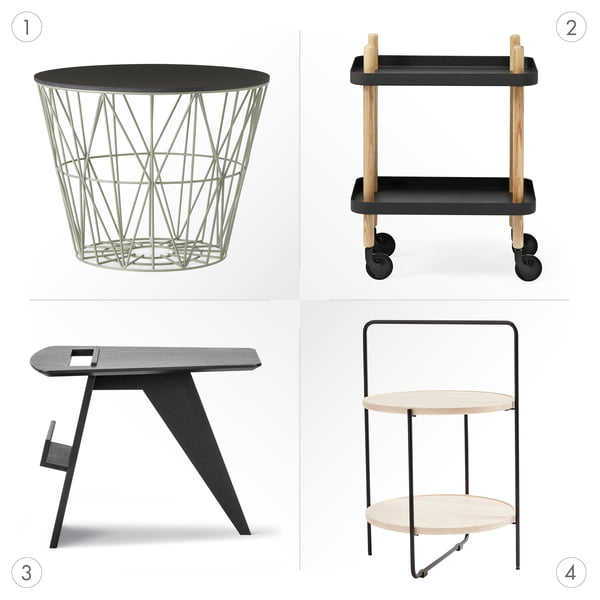
Side tables are not only a beautiful decorative element, but also convince with their additional functions: Models with storage space (1) are based on baskets, while straight side tables with castors (2) are also perfect as desserte. In addition, many side tables have useful attributes such as an integrated tray, a magazine rack (3), a handle (4), an integrated light source or even a charging station.
4. Mix & Match of side tables - this is how it works
The mix of different side table designs is particularly stylish and unique at the same time. The most important rules to keep it harmonious are the preservation of the basic form and the repetition of design features. The reuse of materials, colours or frame types, e.g. column feet or filigree metal frames, creates a stylish ensemble. However, they are free to choose the height, because it is the combination of different side table heights that makes the arrangement expressive and exciting.
The following applies to unusual models: Eye-catchers should remain eye-catchers and it is advisable to complement them with simple minimalist examples.
5. Side table made of metal, wood or glass - choose the right material
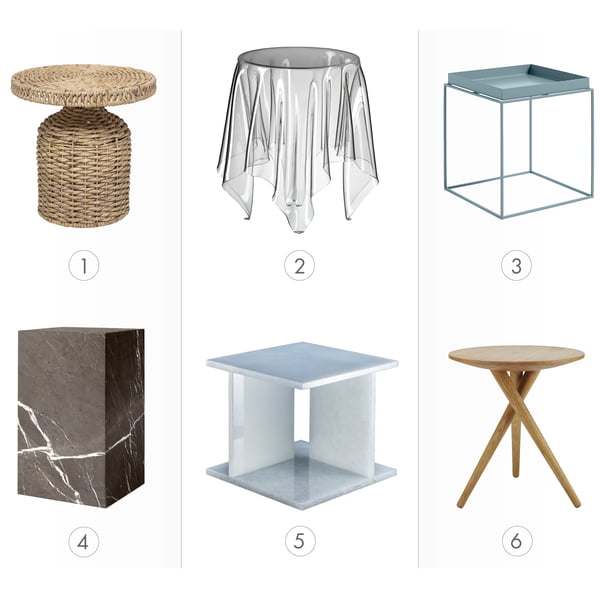
No matter whether side table for the garden, kitchen or living room - the materials and the associated moods of this piece of furniture are as varied as its possible uses.
You will be particularly in line with the trend with a woven side table (1), which attracts attention with its unusual feel and brings naturalness to any room.
Whether you are looking for a side table in white, black or gold - models made of plastic (2) have a very wide range of colours and shapes. They are also easy to clean and, due to their low weight, easy to move.
Side tables made of metal (3) also have these practical characteristics. Due to their robust material they can also be used in the garden or on the balcony.
You can choose a modern model with a side table made of stone (4), which gets its special look from structures and grains. However, some of these tables are very heavy, so that the flexible choice of location is impaired.
With a side table made of (5) wood is a particularly robust and durable piece of furniture that can change colour over time and give warmth and comfort to rooms.
Side tables made of glass (6) on the other hand appear airy, but also modern and cool. Particularly in households with children, safety glass should be used to prevent it from breaking into sharp shards.
While you are free to choose indoors, for side tables that you also want to take outside, make sure you choose teak, powder-coated steel or plastic that is specially marked for outdoor use.
6. Fazit – das sollten Sie beim Kauf eines Design-Beistelltisch beachten
- While the diameter of side tables is less than 60 cm and the height is up to 70 cm, coffee tables usually have a larger diameter and are flatter.
- As an addition to the living area, it is advisable to determine the appropriate shape of the side table based on the type of your sofa.
- Many side tables have useful additional functions such as castors, storage space or handles and are new interpretations of the classic bar trolley, basket or bedside table.
- If you mix side tables with each other, make sure that shapes, materials, colours or frame types can be found several times, while the heights vary considerably in the best case.
- From natural and warm materials such as wicker and wood, to versatile and practical plastic and metal, to unusual glass or stone - side tables are available in a wide variety of materials, each with its own advantages.
- For outdoor use, side tables made of teak, powder-coated steel or weather-resistant plastic are recommended.
Buy design side tables online at Connox - your advantages at a glance
- high-quality side tables - originals of the top design brands
- climate-neutral online shopping
- personal support by our customer service
- fair shipping costs
- secure payment thanks to SSL encryption
Purchasing consulting at Connox
You want to buy design side tables online, but need support? Please feel free to contact our customer service at any time. We are at your side with advice and practical support for your purchase, give recommendations and can quickly clarify questions. Let us then conveniently deliver your desired article directly to your home.
